2. Bayesian Linear Models#
Software
Similar to the torch.nn module in PyTorch containing the most frequently used neural network building blocks, there are also tools for Bayesian inference tasks. In this class we will use the universal probabilistic programming language (PPL) Pyro which is supported by PyTorch on the backend (The corresponding tool in TensorFlow is TensorFlow Probability). At there core, these probabilistic programming systems construct a domain-specific language to express probabilistic models, sample from probability distributions, and utilize their integrated inference engines such as Hamiltonian Monte-Carlo, Sequential Monte-Carlo, Variational Inference, etc. hence making it much easier for us to express probabilistic control flows, as well as representing uncertainties in our algorithms.
# install pyro if now yet installed
!pip3 install pyro-ppl
Requirement already satisfied: pyro-ppl in /home/artur/.venvs/sciml/lib/python3.10/site-packages (1.8.6)
Requirement already satisfied: torch>=1.11.0 in /home/artur/.venvs/sciml/lib/python3.10/site-packages (from pyro-ppl) (2.1.0+cpu)
Requirement already satisfied: tqdm>=4.36 in /home/artur/.venvs/sciml/lib/python3.10/site-packages (from pyro-ppl) (4.66.1)
Requirement already satisfied: opt-einsum>=2.3.2 in /home/artur/.venvs/sciml/lib/python3.10/site-packages (from pyro-ppl) (3.3.0)
Requirement already satisfied: pyro-api>=0.1.1 in /home/artur/.venvs/sciml/lib/python3.10/site-packages (from pyro-ppl) (0.1.2)
Requirement already satisfied: numpy>=1.7 in /home/artur/.venvs/sciml/lib/python3.10/site-packages (from pyro-ppl) (1.26.1)
Requirement already satisfied: networkx in /home/artur/.venvs/sciml/lib/python3.10/site-packages (from torch>=1.11.0->pyro-ppl) (3.2.1)
Requirement already satisfied: jinja2 in /home/artur/.venvs/sciml/lib/python3.10/site-packages (from torch>=1.11.0->pyro-ppl) (3.1.2)
Requirement already satisfied: fsspec in /home/artur/.venvs/sciml/lib/python3.10/site-packages (from torch>=1.11.0->pyro-ppl) (2023.10.0)
Requirement already satisfied: sympy in /home/artur/.venvs/sciml/lib/python3.10/site-packages (from torch>=1.11.0->pyro-ppl) (1.12)
Requirement already satisfied: typing-extensions in /home/artur/.venvs/sciml/lib/python3.10/site-packages (from torch>=1.11.0->pyro-ppl) (4.8.0)
Requirement already satisfied: filelock in /home/artur/.venvs/sciml/lib/python3.10/site-packages (from torch>=1.11.0->pyro-ppl) (3.13.1)
Requirement already satisfied: MarkupSafe>=2.0 in /home/artur/.venvs/sciml/lib/python3.10/site-packages (from jinja2->torch>=1.11.0->pyro-ppl) (2.1.3)
Requirement already satisfied: mpmath>=0.19 in /home/artur/.venvs/sciml/lib/python3.10/site-packages (from sympy->torch>=1.11.0->pyro-ppl) (1.3.0)
import numpy as np
import pandas as pd
import random
# visualization libraries
from matplotlib import pyplot as plt
import seaborn as sns
# PyTorch
import torch
# Pyro
import pyro
import pyro.distributions as dist
from pyro.nn import PyroModule, PyroSample
from pyro.infer.autoguide import AutoDiagonalNormal, AutoMultivariateNormal, init_to_mean
# SVI and Trace_ELBO below are related to Variational Inference, which you are
# not expected to understand yet.
from pyro.infer import SVI, Trace_ELBO, Predictive, MCMC, NUTS
# visualization utilities
plt.rcParams['font.size'] = '16'
def plot_training_curve(loss_vec):
fig = plt.figure(figsize=(10, 6))
plt.plot(np.arange(len(loss_vec)) + 1, loss_vec)
plt.xlabel("Epoch")
plt.ylabel("Loss")
plt.yscale("log")
plt.title("Training curve")
plt.grid()
2.1. Bayesian Linear Regression#
2.1.1. Problem setting#
Given: A set of measurement pairs \(\left\{x^{(i)}, y^{\text {(i)}}\right\}_{i=1,...m}\) with \(x \in \mathbb{R}^{n}\) and \(y \in \mathbb{R}\)
Question: If I give you a novel \(x\), what would be the distribution of the corresponding \(y\)?
Linear regression assumption:
Where we have moved to the more common weights \(w = [\vartheta_1, ..., \vartheta_n]\) and bias \(b=\vartheta_0\) notation. Other than the change of notation, the only difference up until now is the random noise term \(\epsilon\), which can, in general, originate from any probability distribution. The difference to the maximul likelihood interpretation on the normal linear regression we discussed in the lecture on Linear Models is that here we allow for any distribution in contrast to restricting ourselves to the Gaussian.
The other novel part is that in the Bayesian setting the parameters of the model (\(w, b\)) are random variables with some prior distribution.
References
This part is mainly based on this Pyro tutorial and this further code.
2.1.2. Artificial Dataset#
# See Exercise 1 for more details on this dataset
a = 3 # bias
b = 2 # weight
np.random.seed(42)
random.seed(42)
x = np.random.rand(256)
noise = np.random.randn(256) / 4
y = a + b*x + noise
plt.scatter(x, y, color='green')
plt.grid()
plt.show()
# Reshape the input variables for training
x_train = torch.from_numpy(x.reshape(-1, 1).astype('float32'))
y_train = torch.from_numpy(y.astype('float32'))
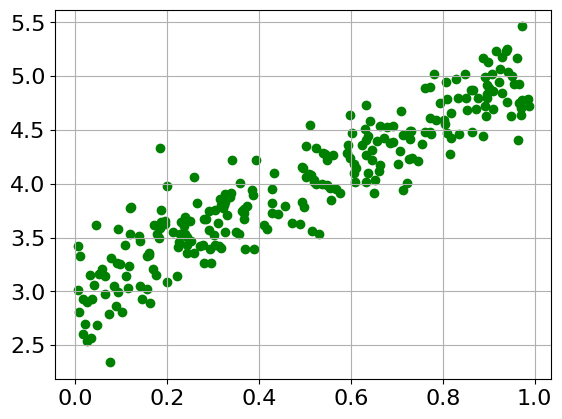
2.1.3. Non-Bayesian (Classic) Linear Regression (revised)#
# Regression model
linear_reg_model = PyroModule[torch.nn.Linear](1, 1)
print("Parameter initialization:")
for name, param in linear_reg_model.named_parameters():
print(name, ": ", param.data)
# Define loss and optimize
loss_fn = torch.nn.MSELoss()
optim = torch.optim.Adam(linear_reg_model.parameters(), lr=0.05)
num_iterations = 1000
loss_vec = np.zeros((num_iterations,))
for j in range(num_iterations):
# run the model forward on the data
y_pred = linear_reg_model(x_train).squeeze(-1)
# calculate the mse loss
loss = loss_fn(y_pred, y_train)
# initialize gradients to zero - has to be done before the .backward step
optim.zero_grad()
# backpropagate
loss.backward()
# take a gradient step
optim.step()
loss_vec[j] = loss.item()
plot_training_curve(loss_vec)
# Inspect learned parameters
print("Learned parameters:")
for name, param in linear_reg_model.named_parameters():
print(name, param.data.numpy())
Parameter initialization:
weight : tensor([[0.0612]])
bias : tensor([-0.0087])
Learned parameters:
weight [[2.0283482]]
bias [2.999293]
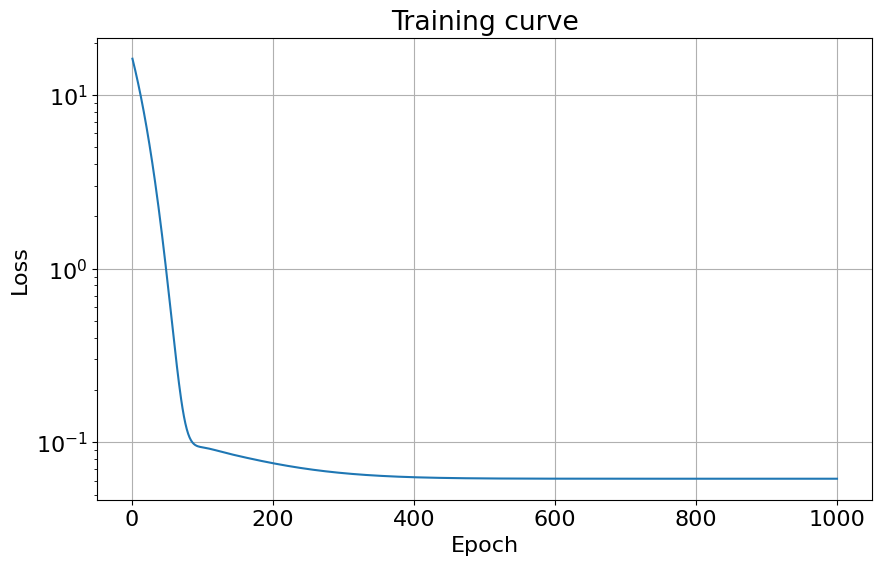
with torch.no_grad():
predicted = linear_reg_model(x_train).data.numpy()
plt.clf()
plt.plot(x_train, y_train, 'go', label='True data')
plt.plot(x_train, predicted, '.', label='Predictions')
plt.legend()
plt.grid()
plt.show()
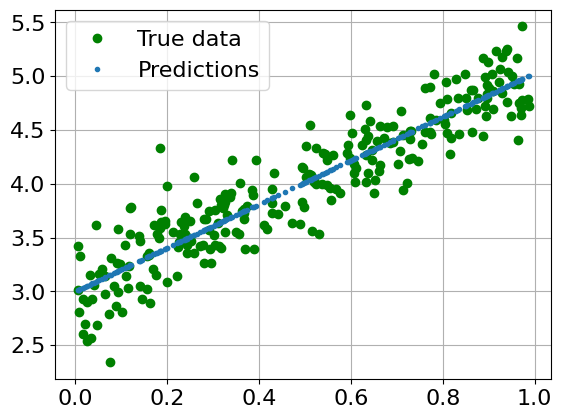
2.1.4. Bayesian Linear Regression Model#
And now we seek to express our Bayesian linear regression model. For a detailed explanation of the terms of this model, see this example. What you should know is that there are three different pieces of model() which are encoded via the mapping:
Observations \(\Longleftrightarrow\)
pyro.samplewith theobsargument.Latent random variables \(\Longleftrightarrow\)
pyro.sample.Parameters \(\Longleftrightarrow\)
pyro.param.
The model below essentially makes the following prior assumptions:
class BayesianLinearRegression(PyroModule):
"""Bayesian linear regression model.
See the Pyro documentation for more details on distributions and shapes:
- https://docs.pyro.ai/en/stable/distributions.html
- https://pyro.ai/examples/tensor_shapes.html
This model implementation is adapted from the Pyro example:
- https://pyro.ai/examples/bayesian_regression.html#
"""
def __init__(self, input_dim, output_dim):
super().__init__()
self.linear = PyroModule[torch.nn.Linear](input_dim, output_dim)
# Use expand() to draw a batch of samples.
# Use .to_event(n) to treat a univariate distribution as multivariate, where n
# is the number of batch dimensions (from the right) to declare as dependent.
self.linear.weight = PyroSample(dist.Normal(
0., 1.).expand([output_dim, input_dim]).to_event(2)) # prior
self.linear.bias = PyroSample(dist.Normal(
0., 10.).expand([output_dim]).to_event(1)) # prior
def forward(self, x, y=None):
sigma = pyro.sample("sigma", dist.Uniform(0., 10.)) # prior
mean = self.linear(x).squeeze(-1)
with pyro.plate("data", x.shape[0]):
# within this context, batch dimension -1 (`x.shape[0]`) is independent
obs = pyro.sample("obs", dist.Normal(mean, sigma), obs=y)
return mean
model = BayesianLinearRegression(1, 1)
2.1.5. MCMC: Sampling and Inference#
In the lecture we saw different Monte Carlo sampling strategies, e.g. Acceptance-Rejection Sampling and Adaptive Rejection Sampling, but the default sampler in Pyro is different. There are multiple reasons for that, some of which include:
in the Acceptance-Rejection approaches, we need to know the constant \(M\), which we often don’t a-priori know
we could use the gradient information of the likelihood surface to find regions with higher probability faster
often we are happy if we know an approximation of the pdf, especially if computing this quantity is very fast, which is why Variational Inference approaches are so popular.
Here, we will see how to use the two most practically relevant approaches, namely Markov Chain Monte Carlo (MCMC) and Stochastic Variational Inference (SVI). We start with MCMC.
The No U-turn Sampler (NUTS, for more information see The No-U-turn sampler: Adaptively setting path lengths in Hamiltonian Monte Carlo by Hoffmann & Gelman, 2014) is a gradient-based MCMC approach. Starting from an initial point it generates a trajectory in the domain space such that the frequency of being in a given region is guaranteed to be proportional to the probability density of that region. For a visual of the NUTS walk see this website.
# Sampling
nuts_kernel = NUTS(model, adapt_step_size=True)
mcmc = MCMC(nuts_kernel, num_samples=300, warmup_steps=100)
mcmc.run(x_train, y_train)
Warmup: 0%| | 0/400 [00:00, ?it/s]
Sample: 100%|██████████| 400/400 [00:05, 76.44it/s, step size=2.88e-01, acc. prob=0.914]
mcmc_samples = mcmc.get_samples()
for k in mcmc_samples.keys():
s = torch.squeeze(mcmc_samples[k])
print(f"{k} = {torch.mean(s).item():.3f} +/- {torch.std(s).item():.3f}")
linear.bias = 3.001 +/- 0.028
linear.weight = 2.022 +/- 0.050
sigma = 0.250 +/- 0.011
for k in mcmc_samples.keys():
print(k, torch.squeeze(mcmc_samples[k]).shape)
linear.bias torch.Size([300])
linear.weight torch.Size([300])
sigma torch.Size([300])
def summary(samples):
site_stats = {}
for k, v in samples.items():
site_stats[k] = {
"mean": torch.mean(v, 0),
"std": torch.std(v, 0),
"5%": v.kthvalue(int(len(v) * 0.05), dim=0)[0],
"95%": v.kthvalue(int(len(v) * 0.95), dim=0)[0],
}
return site_stats
# Inference
predictive = Predictive(model, mcmc_samples,
return_sites=("linear.weight", "obs", "_RETURN"))
samples = predictive(x_train)
pred_summary = summary(samples)
mu = pred_summary["_RETURN"]
y = pred_summary["obs"]
predictions = pd.DataFrame({
"x": x_train[:, 0],
"mu_mean": mu["mean"],
"mu_perc_5": mu["5%"],
"mu_perc_95": mu["95%"],
"y_mean": y["mean"],
"y_perc_5": y["5%"],
"y_perc_95": y["95%"],
"y_true": y_train,
})
predictions = predictions.sort_values(by=["x"])
fig = plt.figure(figsize=(10, 6))
plt.plot(x_train, y_train, 'go', label='True data')
plt.plot(predictions["x"], predictions["mu_mean"], '.', label='Predictions')
plt.fill_between(predictions["x"],
predictions["mu_perc_5"],
predictions["mu_perc_95"],
alpha=0.5)
plt.fill_between(predictions["x"],
predictions["y_perc_5"],
predictions["y_perc_95"],
alpha=0.5)
plt.legend()
plt.grid()
plt.show()
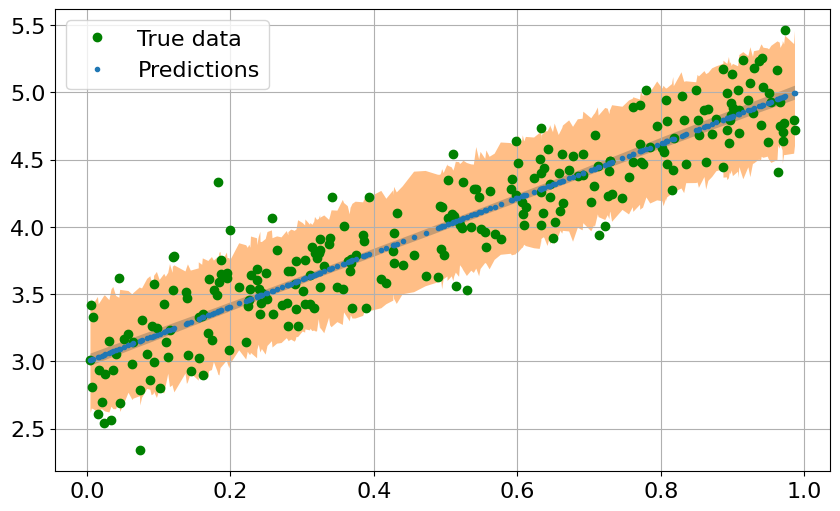
2.1.6. SVI: Training, Sampling and Inference#
An alternative to MCMC (and the default method in Pyro) is Variational Inference (VI). At this point, you are not expected to know how variational inference works. Just remember that MCMC directly gives us samples from the posterior distribution, whereas VI first fits a surrogate posterior pdf and later samples from it as much as we want.
This is how you would construct a training loop with Stochastic VI.
# Training
guide = AutoDiagonalNormal(model)
adam = pyro.optim.Adam({"lr": 0.03})
# Stochastic Variational Inference (SVI) does the heavy-lifting for us.
# We give it 1. a model, 2. a guide that models the distribution of unobserver
# parameters, 3. an optimization routine used to fit parameters, and 4. a loss.
svi = SVI(model, guide, adam, loss=Trace_ELBO())
pyro.clear_param_store()
loss_vec = np.zeros((num_iterations,))
for j in range(num_iterations):
# calculate the loss and take a gradient step
loss = svi.step(x_train, y_train)
loss_vec[j] = loss / len(x_train)
plot_training_curve(loss_vec)
guide.requires_grad_(False)
for name, value in pyro.get_param_store().items():
print(name, pyro.param(name))
AutoDiagonalNormal.loc Parameter containing:
tensor([-3.6379, 2.0213, 3.0067])
AutoDiagonalNormal.scale tensor([0.0420, 0.0280, 0.0153])
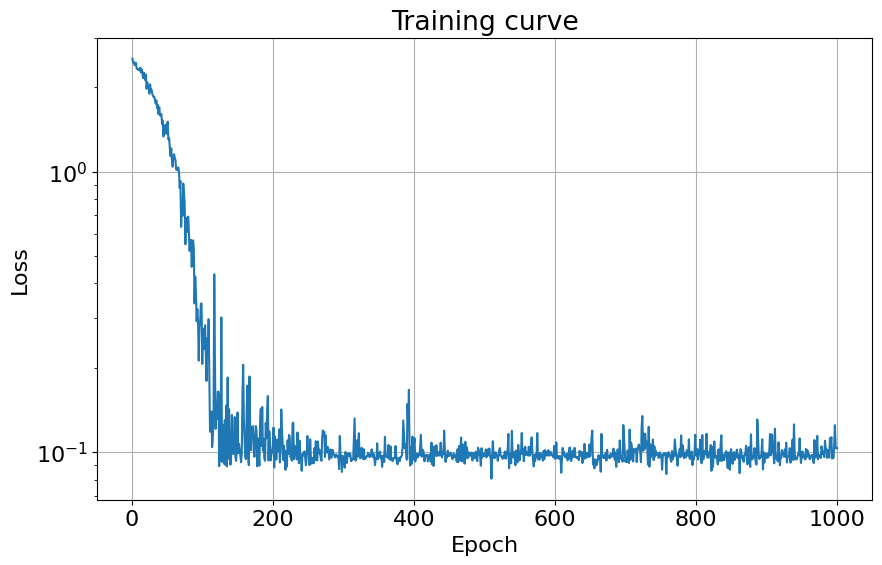
Given a trained model, how to make predictions using it?
# Sampling
predictive = Predictive(model, guide=guide, num_samples=800,
return_sites=("linear.weight", "obs", "_RETURN"))
# Inference
samples = predictive(x_train)
pred_summary = summary(samples)
mu = pred_summary["_RETURN"]
y = pred_summary["obs"]
predictions = pd.DataFrame({
"x": x_train[:, 0],
"mu_mean": mu["mean"],
"mu_perc_5": mu["5%"],
"mu_perc_95": mu["95%"],
"y_mean": y["mean"],
"y_perc_5": y["5%"],
"y_perc_95": y["95%"],
"y_true": y_train,
})
predictions = predictions.sort_values(by=["x"])
fig, ax = plt.subplots(nrows=1, ncols=1, figsize=(10, 6), sharey=True)
ax.plot(x_train, y_train, 'go', label='True data')
ax.plot(predictions["x"], predictions["mu_mean"], '.', label='Predictions')
ax.fill_between(predictions["x"],
predictions["mu_perc_5"],
predictions["mu_perc_95"],
alpha=0.5)
ax.fill_between(predictions["x"],
predictions["y_perc_5"],
predictions["y_perc_95"],
alpha=0.5)
ax.set(xlabel="x",
ylabel="y",
title="Bayesian Linear Regression")
ax.legend()
ax.grid()
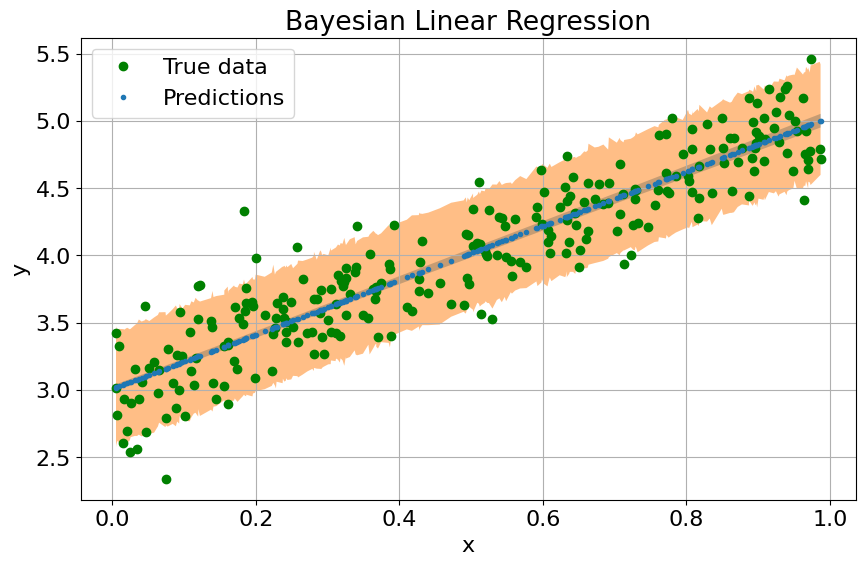
We now need to (automatically) find the best distribution for our model and perform inference over our regression algorithm to learn the posterior distribution over our unobserved parameters.
2.1.7. Exercise#
Apply Bayesian Linear Regression with the Terrain Ruggedness vs GDP dataset from this Pyro tutorial.
####################
# TODO
####################
2.2. Bayesian Logistic Regression#
2.2.1. Iris Dataset (revised)#
from sklearn.datasets import load_iris
X_df, y = load_iris(as_frame=True, return_X_y=True)
target_names = ['setosa', 'versicolor', 'virginica']
# standardize X
X_df.columns = ['sepal_length', 'sepal_width', 'petal_length', 'petal_width']
X = X_df.apply(lambda x: (x - x.mean())/x.std(), axis=0)
X.columns = ['sepal_length', 'sepal_width', 'petal_length', 'petal_width']
X['iris_type'] = y
X['is_setosa'] = np.where(X['iris_type'].values == 0, 1, 0)
X.info()
data = torch.tensor(X[['petal_width']].values, dtype=torch.float)
target = torch.tensor(X['is_setosa'].values, dtype=torch.float)
<class 'pandas.core.frame.DataFrame'>
RangeIndex: 150 entries, 0 to 149
Data columns (total 6 columns):
# Column Non-Null Count Dtype
--- ------ -------------- -----
0 sepal_length 150 non-null float64
1 sepal_width 150 non-null float64
2 petal_length 150 non-null float64
3 petal_width 150 non-null float64
4 iris_type 150 non-null int64
5 is_setosa 150 non-null int64
dtypes: float64(4), int64(2)
memory usage: 7.2 KB
X.head()
| sepal_length | sepal_width | petal_length | petal_width | iris_type | is_setosa | |
|---|---|---|---|---|---|---|
| 0 | -0.897674 | 1.015602 | -1.335752 | -1.311052 | 0 | 1 |
| 1 | -1.139200 | -0.131539 | -1.335752 | -1.311052 | 0 | 1 |
| 2 | -1.380727 | 0.327318 | -1.392399 | -1.311052 | 0 | 1 |
| 3 | -1.501490 | 0.097889 | -1.279104 | -1.311052 | 0 | 1 |
| 4 | -1.018437 | 1.245030 | -1.335752 | -1.311052 | 0 | 1 |
sns.pairplot(data=X, hue='iris_type', palette="colorblind", corner=True); #setosa is easy to distinguish, versicolor and virginica are harder
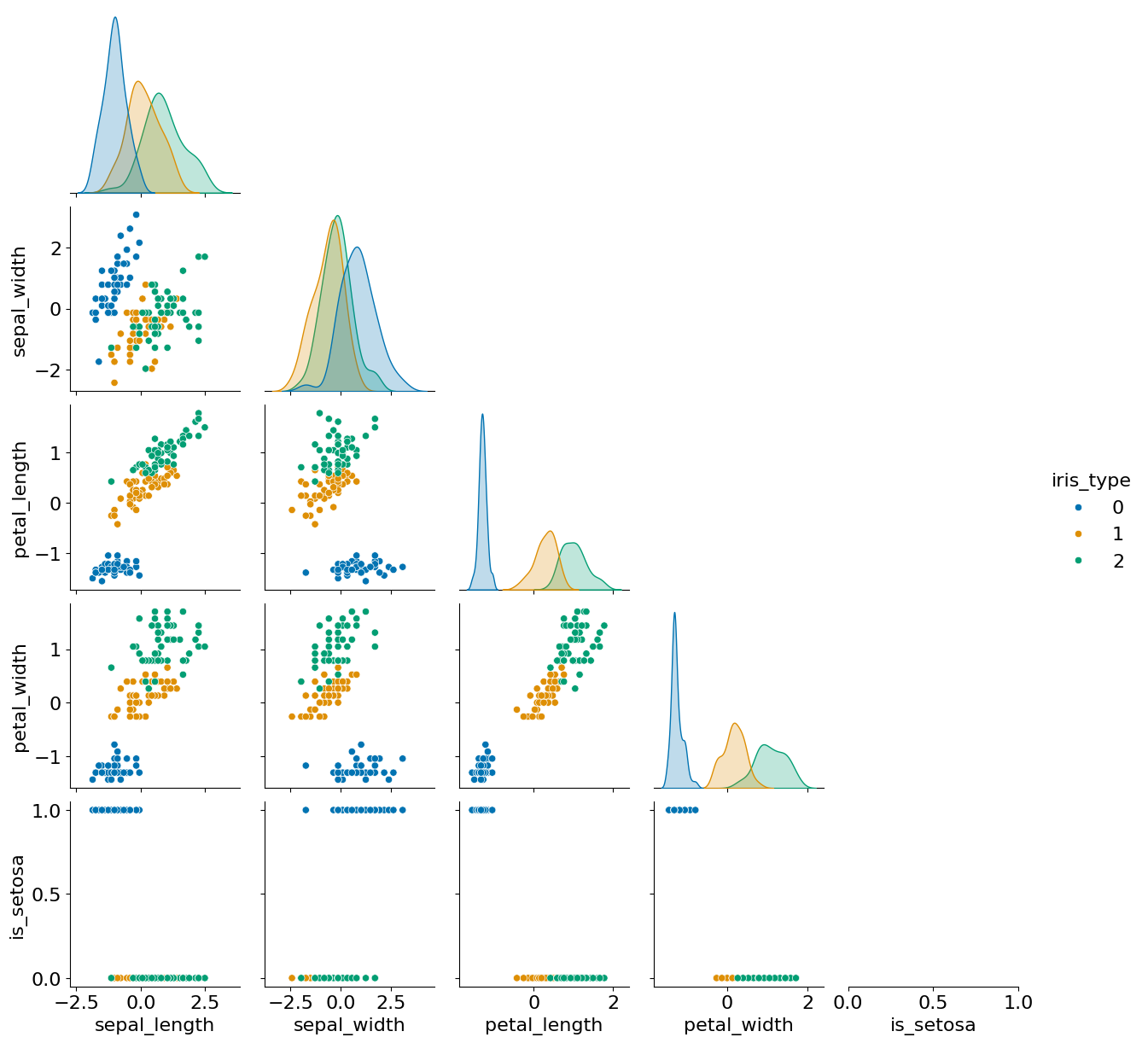
2.2.2. Bayesian Logistic Regression Model#
Taks:
Given “petal_width”, determine whether the class is “setosa”.
The tools used here are the same as for the Bayesian Linear Regression task, thus we omit lengthy explanations. Reach out to us if something is unclear!
Hint: You might consider this useful.
class BayesianLogisticRegression(PyroModule):
def __init__(self, in_features, out_features = 1, bias = True):
super().__init__()
self.linear = PyroModule[torch.nn.Linear](in_features, out_features)
self.linear.weight = PyroSample(dist.Normal(-35., 5.).expand([out_features, in_features]).to_event(2))
if bias:
self.linear.bias = PyroSample(dist.Uniform(-25., 5.).expand([out_features]).to_event(1))
def forward(self, x, y=None):
logits = self.linear(x).squeeze(-1)
with pyro.plate("data", x.shape[0]):
obs = pyro.sample("obs", dist.Bernoulli(logits=logits), obs=y)
return logits
2.2.3. Using SVI#
model = BayesianLogisticRegression(data.size(1))
guide = AutoMultivariateNormal(model, init_loc_fn=init_to_mean)
def train(model, guide, lr=0.01, n_steps=2000):
pyro.set_rng_seed(1)
pyro.clear_param_store()
gamma = 0.01 # final learning rate will be gamma * initial_lr
lrd = gamma ** (1 / n_steps)
adam = pyro.optim.ClippedAdam({'lr': lr, 'lrd': lrd})
svi = SVI(model, guide, adam, loss=Trace_ELBO())
for i in range(n_steps):
elbo = svi.step(data, target)
if i % 500 == 0:
print(f"Elbo loss: {elbo}")
%%time
train(model, guide)
Elbo loss: 9.350290536880493
Elbo loss: 2.805009201169014
Elbo loss: 1.4718698005599435
Elbo loss: 1.9484067456796765
CPU times: user 52.9 s, sys: 7.86 ms, total: 52.9 s
Wall time: 6.62 s
num_samples = 1000
predictive = Predictive(model, guide=guide, num_samples=num_samples)
svi_samples = {k: v.reshape((num_samples,-1)).detach().cpu().numpy()
for k, v in predictive(data, target).items()
if k != "obs"}
for k in svi_samples.keys():
print(k, svi_samples[k].mean())
linear.weight -34.34986
linear.bias -16.362192
guide.quantiles([0.05,0.50,0.95])
{'linear.weight': tensor([[[-37.1637]],
[[-34.3472]],
[[-31.5306]]]),
'linear.bias': tensor([[-20.4056],
[-16.5955],
[-11.3262]])}
svi_samples['linear.weight'].mean(axis=0)
array([-34.34986], dtype=float32)
samples = pd.DataFrame({'bias':svi_samples['linear.bias'].squeeze(), 'weight':svi_samples['linear.weight'].squeeze()})
sns.pairplot(data=samples, corner=True)
<seaborn.axisgrid.PairGrid at 0x7f7c6473fbe0>
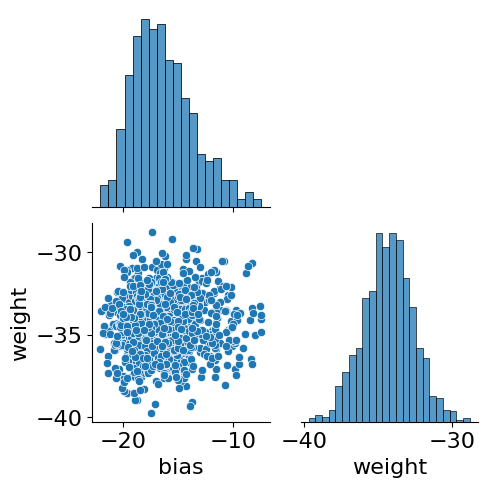
2.2.4. Using MCMC#
nuts_kernel = NUTS(model)
mcmc = MCMC(nuts_kernel, num_samples=300, warmup_steps=100)
%%time
mcmc.run(data, target)
Sample: 100%|██████████| 400/400 [00:04, 82.29it/s, step size=2.22e-01, acc. prob=0.859]
CPU times: user 4.87 s, sys: 600 µs, total: 4.87 s
Wall time: 4.86 s
hmc_samples = {k: v.detach().cpu().numpy() for k, v in mcmc.get_samples().items()}
for k in hmc_samples.keys():
print(k, np.mean(hmc_samples[k]))
linear.bias -17.952686
linear.weight -34.984016
sns.displot(hmc_samples['linear.bias'][:,0])
<seaborn.axisgrid.FacetGrid at 0x7f7c6421c8e0>
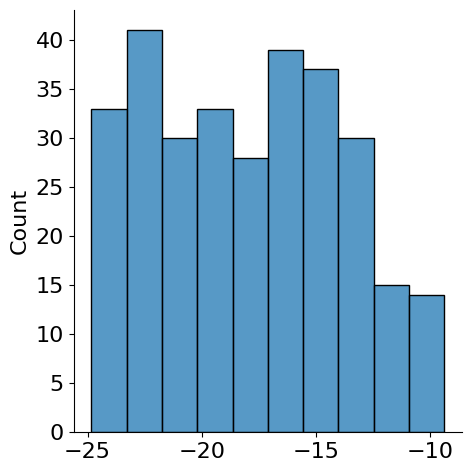
sns.kdeplot(hmc_samples['linear.weight'][:,0,0])
<Axes: ylabel='Density'>
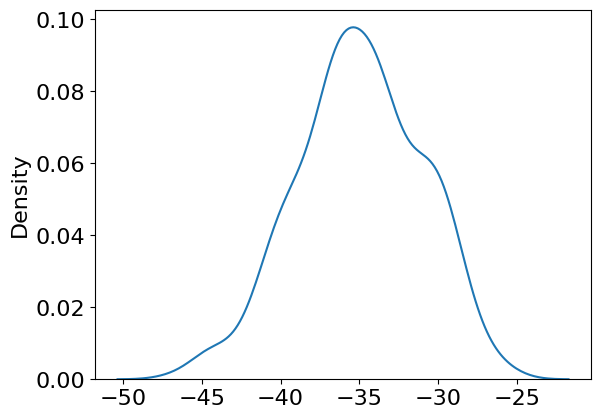
2.2.5. Exercise#
Apply Bayesian logistic regression using all existing inputs:
iris_type ~ sepal_length + sepal_width + petal_length + petal_w
Hint: Look at this code for help.
####################
# TODO
####################

